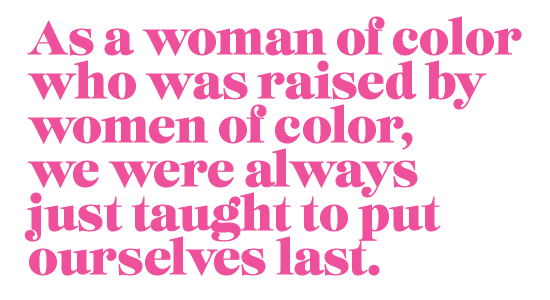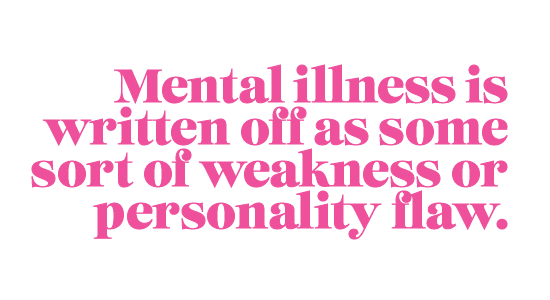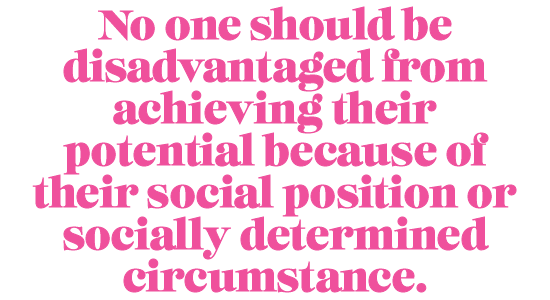Mental Health Disparities Among Women of Color

Across identities, mental illness affects a significant percentage of the U.S. population: approximately 20% of U.S. adults have a diagnosable mental disorder in a given year. [1] Of the 51.5 million adults with mental illness in 2019, less than half (44.8%) received mental health care in the past year. [2] Oklahoma, in particular, fares worse than other states. In Mental Health America’s 2020 report, “State of Mental Health in America,” Oklahoma ranked 38 out of the 50 states and Washington D.C, indicating that its adults have a higher prevalence of mental illness and lower access to care. [3]
Little to no quantitative data exists on Oklahoman women of color’s experiences with mental illness. Yet, as their personal narratives reveal, this population faces unique barriers to care, specific to having both a marginalized race and a marginalized gender. Women of color with mental illness experience pervasive stigma, [4] provider bias, [5] and structural barriers [6] —such as uninsurance—that all adversely affect their mental health and access to mental health services.
Cultural narratives around women of color shape their attitudes towards mental health and contribute to the stigma around mental illness. For example, the “strong Black woman” trope perpetuates unrealistic expectations of strength and resilience for Black women. [7] While this cultural narrative of strength can be empowering for some women, research suggests the trope also negatively affects mental health. [8] In particular, internalized expectations of strength can lead Black women to deny depressive symptoms and avoid mental health care. [9] Similarly, internalization of the “model minority” myth, which paints Asian-Americans as exceptionally hard-working and intelligent, is associated with poor mental health and well-being among this population. [10] These stereotypes are just two examples of many, as each racial group within the broad, generalized category of “women of color” faces their own unique forms of stigma.
The lack of racial diversity among mental health providers [11] constitutes another potential barrier to care, discouraging some women of color from seeking treatment. According to the American Psychological Association, 86% of psychologists are white, and other mental health professions have a similarly homogenous workforce. [12] As one interviewee said, “We don’t have many representatives in the field already, so oftentimes we’re dealing with people who don’t understand what we’ve been through.” Due to implicit bias among providers, people of color, specifically Black individuals, also experience higher rates of misdiagnosis of mental illness, as research has documented. [13] Such data underscores the need to provide pathways for women of color to enter the mental health field.
Structural barriers, embedded within societal institutions such as healthcare, disproportionately affect women of color, impacting their ability to access mental health care. As 2019 data compiled by the Kaiser Family Foundation reveals, women of all minority races in Oklahoma have lower rates of having a primary care doctor than white women. [14] Compared to women of other races, Hispanic women have nearly twice the rate of not seeing a doctor in the past year due to cost. [15] And, despite the progress made by the Affordable Care Act, groups of color are still more likely to be uninsured than the white population. [16] These disparities in insurance status and healthcare access directly translate to disparities in mental health treatment: among people in the U.S. with any mental illness, 49% of white individuals received treatment, compared to 31%, 33%, and 25% of Black, Hispanic, and Asian individuals, respectively. [17]
In the following narratives, women of color share their experiences around mental health and illness in Oklahoma, describing the cultural expectations they must navigate and the disparities they endure. Their stories show the real-life effects of policies and systems around mental health. Yet even as these narratives highlight structural problems in the healthcare system, they provide avenues for change, revealing the power and radical imagination of women of color.
Disclaimer: Narratives are direct quotes from interviewee transcripts unless otherwise notes by [words in brackets]. To protect the privacy of individuals and entities, some names, characters, events and identifiable characteristics have been changed, altered or removed.
Mental Health Disparities Among Women of Color

Across identities, mental illness affects a significant percentage of the U.S. population: approximately 20% of U.S. adults have a diagnosable mental disorder in a given year. [1] Of the 51.5 million adults with mental illness in 2019, less than half (44.8%) received mental health care in the past year. [2] Oklahoma, in particular, fares worse than other states. In Mental Health America’s 2020 report, “State of Mental Health in America,” Oklahoma ranked 38 out of the 50 states and Washington D.C, indicating that its adults have a higher prevalence of mental illness and lower access to care. [3]
Little to no quantitative data exists on Oklahoman women of color’s experiences with mental illness. Yet, as their personal narratives reveal, this population faces unique barriers to care, specific to having both a marginalized race and a marginalized gender. Women of color with mental illness experience pervasive stigma, [4] provider bias, [5] and structural barriers [6] —such as uninsurance—that all adversely affect their mental health and access to mental health services.
Cultural narratives around women of color shape their attitudes towards mental health and contribute to the stigma around mental illness. For example, the “strong Black woman” trope perpetuates unrealistic expectations of strength and resilience for Black women. [7] While this cultural narrative of strength can be empowering for some women, research suggests the trope also negatively affects mental health. [8] In particular, internalized expectations of strength can lead Black women to deny depressive symptoms and avoid mental health care. [9] Similarly, internalization of the “model minority” myth, which paints Asian-Americans as exceptionally hard-working and intelligent, is associated with poor mental health and well-being among this population. [10] These stereotypes are just two examples of many, as each racial group within the broad, generalized category of “women of color” faces their own unique forms of stigma.
The lack of racial diversity among mental health providers [11] constitutes another potential barrier to care, discouraging some women of color from seeking treatment. According to the American Psychological Association, 86% of psychologists are white, and other mental health professions have a similarly homogenous workforce. [12] As one interviewee said, “We don’t have many representatives in the field already, so oftentimes we’re dealing with people who don’t understand what we’ve been through.” Due to implicit bias among providers, people of color, specifically Black individuals, also experience higher rates of misdiagnosis of mental illness, as research has documented. [13] Such data underscores the need to provide pathways for women of color to enter the mental health field.
Structural barriers, embedded within societal institutions such as healthcare, disproportionately affect women of color, impacting their ability to access mental health care. As 2019 data compiled by the Kaiser Family Foundation reveals, women of all minority races in Oklahoma have lower rates of having a primary care doctor than white women. [14] Compared to women of other races, Hispanic women have nearly twice the rate of not seeing a doctor in the past year due to cost. [15] And, despite the progress made by the Affordable Care Act, groups of color are still more likely to be uninsured than the white population. [16] These disparities in insurance status and healthcare access directly translate to disparities in mental health treatment: among people in the U.S. with any mental illness, 49% of white individuals received treatment, compared to 31%, 33%, and 25% of Black, Hispanic, and Asian individuals, respectively. [17]
In the following narratives, women of color share their experiences around mental health and illness in Oklahoma, describing the cultural expectations they must navigate and the disparities they endure. Their stories show the real-life effects of policies and systems around mental health. Yet even as these narratives highlight structural problems in the healthcare system, they provide avenues for change, revealing the power and radical imagination of women of color.
Disclaimer: Narratives are direct quotes from interviewee transcripts unless otherwise notes by [words in brackets]. To protect the privacy of individuals and entities, some names, characters, events and identifiable characteristics have been changed, altered or removed.
Narrative #1
“A Culture Of Sacrifice”
Seeking Mental Health Care as a Woman of Color
The majority of my health journey has been with mental health. I’ve done inpatient care before for mental health. And when I was talking with the doctors they were a lot more intrusive in my family background than they were in what I was telling them. There was a bigger focus on my [past] experiences rather than what I was experiencing at the present moment.
As a woman of color, oftentimes our trauma is re-lived because our health providers don’t know enough about our communities to understand who you are—why you’re experiencing what you’re experiencing. There’s an entire process of getting to know you rather than trying to find solutions for what’s going on with you.
I’ve had therapy where my trauma was actively being used as a way to get to know me, but they didn’t understand that they were triggering it by their lack of knowledge. And I remember that the focus on my trauma made the trauma worse. That’s the main point—they don’t understand the culture that we’re coming from, so they don’t know how to best find solutions. Especially in mental health. We don’t have many representatives in the field already, so oftentimes we’re dealing with people who don’t understand what we’ve been through.

Culture and Mental Health
I’m reading this book called “Finding Latinx.” There’s a statistic here that says 50% of all young Latinas were persistently sad or hopeless nationwide. 10.5% of Latina adolescents age 10-24 in the U.S. will have attempted suicide in the past year. And that’s compared to 7.3% of white females, 5.8% of Latino males, and 4.6% of white male teens. So, the statistics are very dark.
A lot of cultural barriers don’t always get talked about. Mental health is still very taboo in my community. I’m Hispanic, Latinx, and we don’t talk about it. There’s just this culture of suffering where, you know, you have to sacrifice. And sometimes that means not being able to go to the doctor or not being able to have medications. Trying to break those barriers has been tough.

Also, in my culture, it’s a very patriarchal system. As a woman of color who was raised by women of color, we were always just taught to put ourselves last. There’s a culture of sacrifice, and women in my community take that on. And that often trickles down to health as well. In addition to the barriers that come with access to basic care, we carry those traditional and cultural barriers that don’t always give us the opportunity to seek and put our health first. Women in my community would rather put their children’s health first than their own. And, ideally, we should be able to have care for everybody.
Women are often silenced when they need their needs met, when they need to go to the doctor. Like we are just supposed to grin and bear it, and it’s a very tough process to go through.
Family and Community Contexts
As I was growing up, my family was very impoverished. We didn’t really have access to basic care. We didn’t have health insurance. So, we had to go often to the Health Department and get our care there. I remember my mother would go there, and the only reason that she was able to get things like a mammogram was because they had programs set in place where she could do that free of cost, or at a lower cost. Anything from dental care to just general medications was really hard to access because we didn’t have health insurance.
At times, we would go without care because we just couldn’t afford it. Home remedies are basically what got us through any sickness, and for more serious issues with health, it was just a huge burden to have to go to a doctor and take on that medical debt. I remember a few times going to the emergency room because I used to have asthma, and it was just such a weight on my family for us to have to do that. Which it shouldn’t be, but the cost of care is so high that oftentimes, it’s not possible for a lot of people to have it.

Community Needs and Policy Visions
I would like to see more protections for women and access to health care that is free or at a low cost. A lot of our community is not able to access care because they cannot afford it. And that should not be something that deters somebody from going to the doctor. It should not be something that’s still happening.
A lot of women are going without having basic health care needs. And if it wasn’t for programs that they have at the health department, where you can go to the dentist for a low cost or have a general check-up— if that wasn’t available, they wouldn’t have anything. We don’t have the ability to access private health care and strengthening our public health care, making it more affordable but also just better, would help our community tremendously. Because then we would have people that actually care about the community, and services that are actually useful. So just access to basic health care would go a long, tremendous way. And especially for women in the community, they would feel much more empowered to put their health care needs first if they knew that it was affordable and it was going to be right for what they were needing.
In Oklahoma, it’s very hard, in my opinion, to be a woman. We are in a very conservative state, and a lot of that infringes on our ability to choose our own health for our bodies. As a young woman, I feel like there’s constantly legislation going through Congress that tries to take away our rights, especially abortion rights and birth control. You would think we would be more open to allowing women to take care of their health, but it seems like almost every year there’s new bills going through the Senate trying to take our rights away.

The other day, I tried to go in for a Pap smear, and they have since changed the age requirement to 25. There’s no dispersing information to our community. We need more advocating, more access to resources, more information to the public about what the new changes are. Advocating for women’s rights over our own [bodies], and more representatives in the health field.
With the previous administration that we had, a lot of programs and federal aid that was available was taken away. A lot of people were afraid to reach out for help and, even for their children, get a free meal and reduced lunch program because they didn’t know whether that would affect them later on in their life.
We haven’t had any progress because so much of the community is tokenized. Our lives are being played with by some of our politicians and our government. It feels like we are just an agenda item. There’s organizations here in Oklahoma that are providing for more rights and access but it’s so hard to make a breakthrough when so many of our representatives are taking steps to take away rather than to provide more access.
We’re still very much fighting for our freedom, and trying our best for our votes to count. And trying to have autonomy over our own bodies.

Narrative #2
"Remove The Stigma”
Experiences as an Immigrant Woman of Color in Oklahoma
I’m a South Asian immigrant, I’ve been living in Oklahoma for a few years, I immigrated to the U.S. and I’m a single mother.
I definitely am exploited a lot. A lot of times when I’m trying to get work done, I’m looked upon as not capable of the work I’m undertaking and dismissed. Many times I have to put white men as the face of my work for me to be able to access help or resources. If I have professional success because of the quality of my work, or successes, a lot of times I get resentment from people questioning how I deserve that or how I’m entitled to that. It’s just exploitation on many levels that I have to go through.
But my experience of Oklahoma is also limited to the city in which I live—this being the most progressive part of Oklahoma. There is one part of my experience living in Oklahoma that has been really good because within this progressive community I have a lot of support that I don’t have outside and that support completely changes my experience. So if you surround yourself with a community, a group of people who support people of color or do not discriminate against them, then your experience of living in Oklahoma or any other state can be completely different than going out in the world and operating on your own.

Mental Health Care Access
When I first experienced mental health problems in my family, and also myself personally as a result of traumatic episodes in my life, I had financial privilege so accessing health care was relatively easy due to that. However, when I didn’t have that privilege of financial resources, I saw the disparity in healthcare access and how it was a lot harder for me.
One area that I especially struggled with is finding therapists that could relate to my culture and my problems without imposing the Western ideologies or their own ideologies on me, or without looking at me as an oppressed female coming from a backwards culture. I especially struggled with white male and white female therapists. Most of my therapy time was spent in educating them, explaining things to them, and dismantling their stereotypes about my culture instead of getting the benefit of therapy.

I finally came across a therapist who was African-American and I saw a huge difference. Even though she wasn’t from my culture, I didn’t have to explain a lot of my experiences to her. She understood. So I realized that a lot of those experiences were also experiences of racial discrimination and exploitation that I had been going through without really being aware of it as much [though] I grew more aware of it over years. So I especially then looked for therapists who were people of color, female therapists and once I narrowed it down to that category I was able to find a therapist who could relate to my experiences and help me. So I think that a lot of the problem of accessing mental health care is because there aren’t enough therapists from different ethnic backgrounds or enough [therapists] of color. The only therapist that pulled up under my insurance was a white male advertising his therapy based in Christian ideology. And so there’s a lot of limitations around that.
Sometimes a lot of traumas can only heal through therapy. But it’s difficult to find that help when you are a person of color and an immigrant and you’ve gone through a lot of exploitation.

Culture and Mental Health
In the South Asian community and culture that I come from, [mental illness] is a huge taboo. People are thought of as crazy if [they have] any mental health problem. For women, it’s even more of a taboo. It’s something that you have to hide and cannot talk about because there’s just a level of discrimination which makes you not accepted.
Mental illness is written off as some sort of weakness or personality flaw. [People say] that you either don’t pray enough or [there is] something that you don’t do right in your life that is the cause of all the mental health problems. In most communities [mental health issues] are not even accepted as valid. You are [perceived as] somehow not being emotionally strong. It’s not understood and so there’s a lot of stigma around mental illness and outright denial of it.
Within the American culture, people of color and immigrant people of color with mental health problems are stigmatized a lot more than white people. We are traumatized further instead of given any support which is a deterrent for people of color seeking support.

Policy Visions
[We need to] have more people of color, from different ethnic backgrounds, working as therapists and social workers, [with] more opportunities and platforms to be provided to these people from different communities. [Then we would] be able to address mental health issues of different communities who wouldn’t be comfortable in therapy sessions with a therapist who is not coming in with an informed knowledge of their backgrounds and cultures.
What is also really important is insurance coverage for therapy because therapy is very expensive. Most people are unable to get that help because they cannot afford it, [or] health insurance doesn’t cover it. There should be programs initiated to provide that access at a sliding scale for people to make it affordable for them. The sliding scale is really important because that’s how I am able to afford therapy.
There should be more education in communities and public education systems around mental illness to normalize it and to remove the stigma around mental illness. Because even when my children were going through mental health problems, there was so much stigma around it. [Mental illness] is seen as some sort of weakness or defect that disqualifies you from opportunities somehow. There needs to be more awareness of these issues and how common these problems are.
Sometimes functional medicine is able to address these issues when allopathic medicine can’t. There is a statistic that 30% of the people that take antidepressants find that they do not respond to or have adverse [reactions] to antidepressants so they struggle throughout their life without any solution. Functional medicine has solutions that can help those people except that it’s not covered by health insurance, it’s really expensive, so I think functional medicine practices should become incorporated into health insurance plans. Statewide programs to supplement the care that is offered through insurances like therapy sessions and a lot of other educational programs would also help. These are some of the key areas that are really lacking and need to be addressed.

Final Thoughts
Where I come from, I wasn’t raised as a person of color, a woman of color, with all these labels of brown and POC and WOC. These are hierarchies of identities and labels placed by the Western cultures on people to categorize them. In an ideal future, there wouldn’t be any categories and hierarchies of systems in which people are labeled. If those labels are removed and these systems are removed, then this would be a completely different world.
Organization Q&A: Be Well Community Development Corporation (Be Well CDC)

What is Be Well CDC?
Be Well CDC is a 501(c)3 cross-sector organization rooted in the principles of public health. Focus Areas:
- Health | Minority Health & Wellbeing
- Housing | Homeownership & Financial Literacy
- Education | STEAM, College & Career Readiness, Food Sovereignty
What is the mission and/or goal of Be Well CDC?
Our mission is to advance the health and quality of life for residents in Tulsa’s District 1 by convening people, ideas, and resources. We will work to improve the sustainability of efforts that address health improvements in a context-specific, empowering, and culturally sensitive way.
How does Be Well CDC work to address health disparities among women of color?
This year a subcommittee of the Health & Healthcare Task Force completed focus groups with community partners and participants to get direct feedback on how to improve the quality of health among expecting women of color.
Does Be Well CDC offer training/classes open to the community?
Program Objectives:
- Bring together resources for the community in a culturally appropriate and responsive manner
- Enhance personal and community capacity,
- Address health disparities, and improving health outcomes
Initiatives:
- North Tulsa Forward Program was created by the Be Well Community Development Corporation to support potential and existing homeowners with navigating the entire lifecycle of the homeownership process. The program is set to launch in December of 2021.
- Joyful Movement North Tulsa is an initiative that encourages physical activity and movement as a means of improving mental health.
- AMEA collaboratively builds upon recommendations from Healthy People 2020 to develop a pathway for understanding and supporting healthy pregnancy outcomes by focusing on systemic issues in maternal care delivery for minority women.
- North Tulsa Community Gardens Network works to ensure that the larger community is aware of active community gardens in north Tulsa. They increase the amount of goods directly harvested from the community gardens and distributed to the north Tulsa community. They also identify potential funding, donation, and collaborative opportunities for community gardens in north Tulsa.
- Collective 1 is a group of people acting as a cooperative enterprise regarding issues in north Tulsa. Each month we convene stakeholders, community advocates, and organizations to converse with the community regarding topics deemed as important.
- Unity Book Club aims to create a space to bring all ages together over great literature. This includes students (6-12th grade), families, senior citizens living, working, or worshiping in north Tulsa.
How can individuals access your resources?
You can view our website at bewellcdc.org or follow us on social media, Be Well CDC on Facebook, and @bewellcdc on Instagram
Why is this work important? Why do you choose to do this work?
No one should be disadvantaged from achieving their potential because of their social position or socially determined circumstance. North Tulsans deserve to have advocates that want to see them thrive and experience improved health outcomes. We want to see north Tulsa Thrive.
What is Be Well CDC?
Be Well CDC is a 501(c)3 cross-sector organization rooted in the principles of public health. Focus Areas:
- Health | Minority Health & Wellbeing
- Housing | Homeownership & Financial Literacy
- Education | STEAM, College & Career Readiness, Food Sovereignty
What is the mission and/or goal of Be Well CDC?
Our mission is to advance the health and quality of life for residents in Tulsa’s District 1 by convening people, ideas, and resources. We will work to improve the sustainability of efforts that address health improvements in a context-specific, empowering, and culturally sensitive way.
How does Be Well CDC work to address health disparities among women of color?
This year a subcommittee of the Health & Healthcare Task Force completed focus groups with community partners and participants to get direct feedback on how to improve the quality of health among expecting women of color.
Does Be Well CDC offer training/classes open to the community?
Program Objectives:
- Bring together resources for the community in a culturally appropriate and responsive manner
- Enhance personal and community capacity,
- Address health disparities, and improving health outcomes
Initiatives:
- North Tulsa Forward Program was created by the Be Well Community Development Corporation to support potential and existing homeowners with navigating the entire lifecycle of the homeownership process. The program is set to launch in December of 2021.
- Joyful Movement North Tulsa is an initiative that encourages physical activity and movement as a means of improving mental health.
- AMEA collaboratively builds upon recommendations from Healthy People 2020 to develop a pathway for understanding and supporting healthy pregnancy outcomes by focusing on systemic issues in maternal care delivery for minority women.
- North Tulsa Community Gardens Network works to ensure that the larger community is aware of active community gardens in north Tulsa. They increase the amount of goods directly harvested from the community gardens and distributed to the north Tulsa community. They also identify potential funding, donation, and collaborative opportunities for community gardens in north Tulsa.
- Collective 1 is a group of people acting as a cooperative enterprise regarding issues in north Tulsa. Each month we convene stakeholders, community advocates, and organizations to converse with the community regarding topics deemed as important.
- Unity Book Club aims to create a space to bring all ages together over great literature. This includes students (6-12th grade), families, senior citizens living, working, or worshiping in north Tulsa.
How can individuals access your resources?
You can view our website at bewellcdc.org or follow us on social media, Be Well CDC on Facebook, and @bewellcdc on Instagram
Why is this work important? Why do you choose to do this work?
No one should be disadvantaged from achieving their potential because of their social position or socially determined circumstance. North Tulsans deserve to have advocates that want to see them thrive and experience improved health outcomes. We want to see north Tulsa Thrive.

1 “NIMH » Mental Illness.” Accessed June 8, 2021. https://www.nimh.nih.gov/health/statistics/mental-illness.
2 Ibid
3 Mental Health America. “Ranking the States.” Accessed June 8, 2021. https://www.mhanational.org/issues/ranking-states.
4 Nadeem, Erum, Jane M. Lange, Dawn Edge, Marie Fongwa, Tom Belin, and Jeanne Miranda. “Does Stigma Keep Poor Young Immigrant and U.S.-Born Black and Latina Women From Seeking Mental Health Care?” Psychiatric Services 58, no. 12 (December 1, 2007): 1547–54. https://doi.org/10.1176/ps.2007.58.12.1547.
5 Olbert, Charles M., Arundati Nagendra, and Benjamin Buck. “Meta-Analysis of Black vs. White Racial Disparity in Schizophrenia Diagnosis in the United States: Do Structured Assessments Attenuate Racial Disparities?” Journal of Abnormal Psychology 127, no. 1 (January 2018): 104–15. https://doi.org/10.1037/abn0000309.
6 “Racial Disparities.” Healthy Minds Policy Initiative , n.d. https://www.healthymindspolicy.org/wp-content/uploads/2020/07/HMO- One-Pager-Racial-Disparities-FINAL.pdf.
7 Taylor, Jamila, and Christy M. Gamble. “Suffering in Silence.” Center for American Progress. Accessed June 8, 2021. https://www. americanprogress.org/issues/women/reports/2017/11/17/443051/suffering-in-silence/.
8 Jasmine A. Abrams, Ashley Hill, and Morgan Maxwell, “Underneath the Mask of the Strong Black Woman Schema: Disentangling Influences of Strength and Self-Silencing on Depressive Symptoms among U.S. Black Women,” Sex Roles80 (2019): pp. 517-526, https://doi.org/10.1007/s11199-018-0956-y.
9 Taylor, Jamila, and Christy M. Gamble. “Suffering in Silence.” Center for American Progress. Accessed June 8, 2021. https://www. americanprogress.org/issues/women/reports/2017/11/17/443051/suffering-in-silence/.
10 Gupta, Arpana, and Dawn M. Szymanski. “The ‘Model Minority Myth’: Internalized Racialism of Positive Stereotypes as Correlates of Psychological Distress, and Attitudes Toward Help-Seeking.” Asian American Journal of Psychology 2, no. 2 (2011): 101–14. https://doi. org/10.1037/a0024183.
11 Buche, Jessica, Angela J. Beck, and Phillip M. Singer. “Factors Impacting the Development of a Diverse Behavioral Health Workforce .” Behavioral Health Workforce Research Center, February 2017. https://behavioralhealthworkforce.org/wp-content/uploads/2017/05/ FA2P1_Workforce-Diversity_Final-Report.pdf.
12 Luona Lin, Karen Stamm, and Peggy Christidis, “How Diverse Is the Psychology Workforce?” (American Psychological Association, February 2018), https://www.apa.org/monitor/2018/02/datapoint.
13 Olbert, Charles M., Arundati Nagendra, and Benjamin Buck. “Meta-Analysis of Black vs. White Racial Disparity in Schizophrenia Diagnosis in the United States: Do Structured Assessments Attenuate Racial Disparities?” Journal of Abnormal Psychology 127, no. 1 (January 2018): 104–15. https://doi.org/10.1037/abn0000309.
14 KFF, “Women Who Report Having No Personal Doctor/Health Care Provider by Race/Ethnicity,” KFF, n.d., https://www.kff.org/ racial-equity-and-health-policy/state-indicator/females-report-no-personal-doctor-by-race-ethnicity/.
15 KFF, “Women Who Report Not Seeing a Doctor in the Past 12 Months Due to Cost by Race/Ethnicity,” KFF, n.d., https://www.kff.org/ womens-health-policy/state-indicator/females-who-did-not-see-a-doctor-in-the-past-12-months-due-to-cost-by-raceethnicity/.
16 Damico, Anthony. “Changes in Health Coverage by Race and Ethnicity since the ACA, 2010-2018.” KFF (blog), n.d. https://www.kff. org/racial-equity-and-health-policy/issue-brief/changes-in-health-coverage-by-race-and-ethnicity-since-the-aca-2010-2018/.
17 “Racial Disparities.” Healthy Minds Policy Initiative , n.d. https://www.healthymindspolicy.org/wp-content/uploads/2020/07/HMO- One-Pager-Racial-Disparities-FINAL.pdf.



